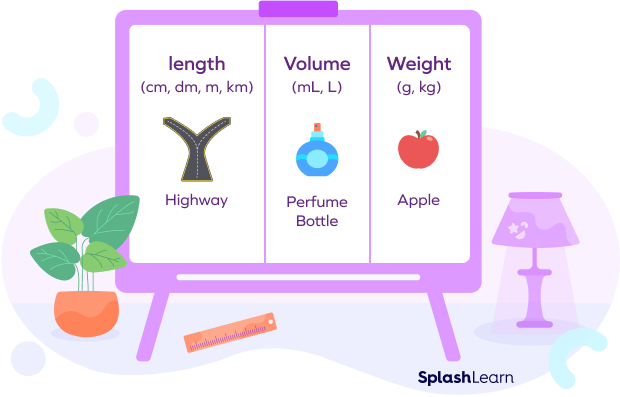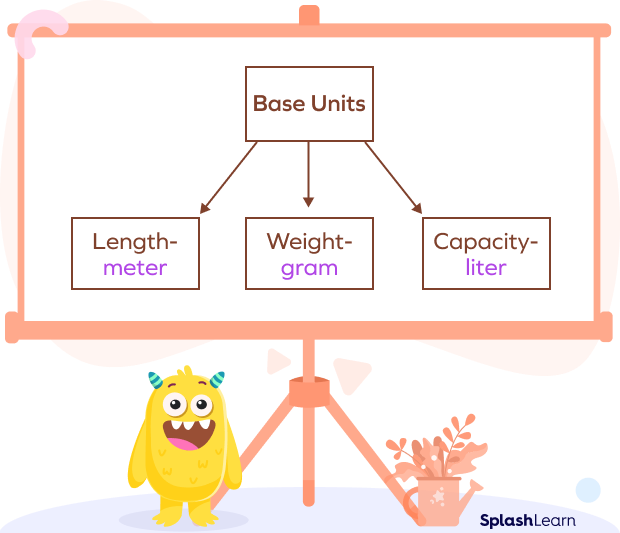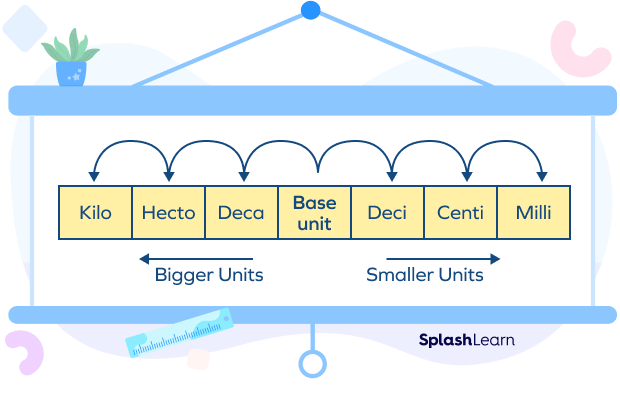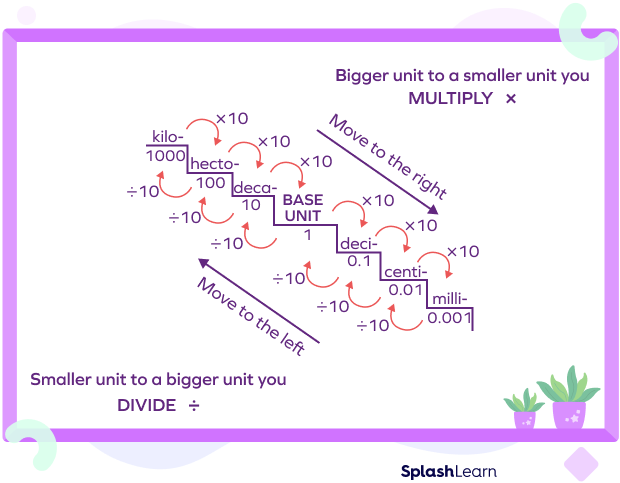What is Metric System?
The metric system is a system of measuring things. It is used worldwide in calculations and research. Here are some examples of how we measure things using the metric system:
- Meter is the unit of measuring distances and lengths. We use this unit in our daily life, for example, the distance between school and home, length of cloth, etc.
- You may have noticed that there is a weight mentioned in the bag of your favourite snack. For example, 250 grams of potato chips. Here, gram is the unit of weight.
- Similarly, on the bottle of your favourite beverage, there’s volume mentioned (for example, 250 milliliters of cola). Here, milliliter is the unit of volume.

Recommended Games
Metric Units
The units for length, weight (mass) and capacity(volume) in the metric system are:
Length: Millimeter (mm), Decimeter (dm), Centimeter (cm), Meter (m), and Kilometer (km) are used to measure how long or wide or tall an object is.
Examples include measuring the thickness or length of a debit card, length of cloth, or distance between two cities.
Weight: Gram (g) and Kilogram(kg) are used to measure how heavy an object is, using instruments.
Examples include measuring the weight of fruits or our own body weight.
Capacity: Milliliter (ml) and Liter (l) are used to measure how much quantity of liquid an object can hold.
Examples include measuring the amount of juice in a juice can, or amount of water in a water tank.
Metric Conversions

The metric system is a system of measurement that uses the meter, liter, and gram as base units of length (distance), capacity (volume), and weight (mass) respectively.
To measure smaller or larger quantities, we use units derived from the metric units.

- The given figure shows the arrangement of the metric units, which are smaller or bigger than the base unit.
- The units to the right of the base unit are smaller than the base unit. As we move to the right, each unit is 10 times smaller or one-tenth of the unit to its left. So, a ‘deci’ means one-tenth of the base unit, ‘centi’ is one-tenth of ‘deci’ or one-hundredth of the base unit and ‘milli’ is one-tenth of ‘centi’ or one-hundredth of ‘deci’ or one-thousandth of the base unit.
- The units to the left of the base unit are bigger than the base unit. As we move to the left, each unit is 10 times greater than the unit to its right. So, a ‘deca’ means ten times of the base unit, ‘hecto’ is ten times of ‘deca’ or hundred times of the base unit and ‘kilo’ is ten times of ‘hecto’ or thousand times of the base unit.
Here’s how we can multiply or divide for making metric conversions. To convert a bigger unit to a smaller unit, we move left to right, we multiply by 10. Moving right to left, from smaller units to bigger, we divide by 10.

The Metric System in Our Daily Life
We use the metric system in our daily life in many ways. Let us look at some everyday examples of the metric system.

- Water in a tank or a liquid in a container is measured in liters. It is the metric unit of volume.
- When we travel in a vehicle, we measure the distance travelled in meters or kilometers.
- When we buy groceries, they are measured in weight units such as grams and kilograms.
The US Standard Units or the Customary/Imperial System units.
This system measures:
- Length or distance in inches, feet, yards, and miles.
- Capacity or volume in fluid ounces, cups, pints, quarts or gallons.
- Weight or mass in ounces, pounds and tons.
Conclusion on Metric System
Every day, we measure weights, lengths, distances, etc. The system that is followed for such measurements is called the metric system. Meter, liter, and gram are the basis of measurement for length, volume, and weight respectively. In this article, we have explained all about the metric system with the help of images and examples. To view more such lessons, visit SplashLearn.
Solved Examples on Metric System
Question 1: What do the following values and units indicate: 20 meters, 150 kilometers, 50 meters?
Answer: Meters and kilometers are units used to indicate length or distance.
Question 2: What are different measuring units for height?
Answer: Height can be measured with the units of length measurement. Therefore, in a metric system, height can be measured in meters, and centimeters.
Question 3: In what units can the following be measured:
- A bag full of apples
- A bucket of water
Answer: A bag full of apples can be measured with weight units such as kilograms or grams. A bucket full of water can be measured with units of volume, such as a liter.
Practice Problems on Metric System
Metric System
What unit is used for measurement of weight?
Grams are the unit of weight.
Kilogram is a unit of what?
Kilogram is a unit of weight.
What is the unit of liquid matter?
Liter is the unit of measurement for liquid matter.
Which of the options is not a metric unit?
Feet is not a metric unit. It is an imperial system of units.
Frequently Asked Questions on Metric System
What are metric prefixes?
Metric system of measurement have prefixes such as “deka, hecto, and kilo” meaning 10, 100, and 1,000 and “ deci, centi, and milli” meaning $\bigg(\frac{1}{10}\bigg)^{th}$ , $\bigg(\frac{1}{100}\bigg)^{th}$ , and $\bigg(\frac{1}{1000}\bigg)^{th}$ respectively with the name of the unit
How did people measure things before the metric system?
Before the metric system, people around the world used their own standards for the measurement of various objects.
How is the metric system different from the imperial system?
Metric and imperial systems are systems for measuring different values. Most of the countries use metric systems as the standard for measurement. At present, only three countries use imperial systems. These are the USA, Vietnam, and Liberia.
Is meter a unit of distance?
Yes, the meter is a unit of distance.


























